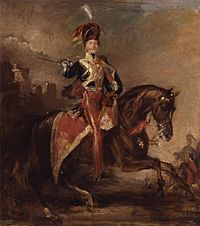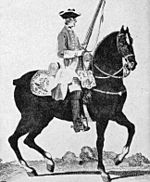11th Hussars facts for kids
Quick facts for kids 11th Hussars (Prince Albert's Own) |
|
|---|---|
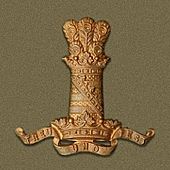
Badge of the 11th Hussars
|
|
| Active | 1715–1969 |
| Country | |
| Branch | |
| Type | Cavalry |
| Role | Line cavalry |
| Size | Regiment |
| Nickname(s) | The Cherry Pickers, The Cherrybums, from which the more genteel Cherubims |
| Motto(s) | Treu und Fest (Loyal and Sure) |
| Anniversaries | Balaclava (25 October) |
| Commanders | |
| Notable commanders |
James Brudenell, 7th Earl of Cardigan |
The 11th Hussars (Prince Albert's Own) was a special group of soldiers in the British Army. They were a cavalry regiment, which means they fought on horseback. This group was started way back in 1715. They served for a very long time, even fighting in the First World War and Second World War. In 1969, they joined with another group, the 10th Royal Hussars, to form a new regiment called the Royal Hussars.
Contents
A Look at Their Early History
How the Regiment Started
The 11th Hussars began in July 1715 in a town called Colchester. They were first known as "Honeywood's Regiment of Dragoons." A dragoon was a soldier who could fight both on horseback and on foot. This group was one of 16 new regiments created to help stop a rebellion in England called the 1715 Jacobite rising. They fought in the Battle of Preston, which helped end the revolt in England. Many of these new groups were later disbanded, but Honeywood's Regiment kept going.
In 1745, another rebellion happened, the 1745 Jacobite rising. The regiment was involved in a small fight called the Clifton Moor Skirmish. This is thought to be the last military fight on English land. They also fought at Culloden in April 1746, which is often called the last big battle on British land. After 1751, regiments were given numbers instead of being named after their leader. So, they became the 11th Regiment of Dragoons.
Fighting in Europe
When the Seven Years' War began in 1756, the regiment took part in attacks on French towns like St Malo and Cherbourg in 1758. These attacks tried to distract French forces. In May 1760, the regiment went to Germany. They won their first special award, called a battle honour, at the Battle of Warburg in July. They also helped win the Battle of Villinghausen in July 1761. This victory made the French go on the defensive and led to a peace agreement in 1763.
In 1783, the 11th Regiment changed from "dragoons" to "light cavalry." This meant they focused more on fast movements and scouting. They were renamed the 11th Regiment of Light Dragoons. During the French Revolutionary Wars, parts of the regiment fought in the Low Countries from 1793 to 1795. They were also involved in battles in Holland in 1799.
The 19th Century: Famous Battles and New Uniforms
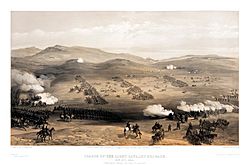
The regiment did not see much action again until 1811, when they went to Portugal for the Peninsular War. In Spain, a small group of ten soldiers was captured near a cherry orchard. This event might be why the regiment got its famous nickname, The Cherry Pickers. They fought in important battles like Badajoz in 1812 and the Battle of Salamanca in July 1812. Later, in 1815, they were part of the battles of Quatre Bras and Waterloo.
From 1819 to 1836, the regiment was stationed in India. Just before they returned to Britain, the Earl of Cardigan became their leader. He made many changes to make the regiment more prestigious.
Prince Albert's Influence
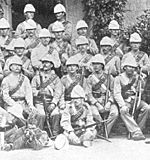
In 1840, the 11th Light Dragoons escorted Prince Albert when he arrived in England to marry Queen Victoria. Queen Victoria then made Prince Albert the "colonel of the regiment." She also gave them a new name: 11th (Prince Albert's Own) Hussars. Prince Albert was very interested in military tactics and equipment. He even helped design the regiment’s new uniforms. By chance, the fancy Hussar uniform included crimson, or "cherry," coloured trousers. These trousers were unique among British regiments and have been worn ever since for most formal uniforms.
The regiment fought in the Crimean War. They were part of the Light Brigade, which was led by Cardigan. They fought at the Battle of Alma in September 1854. They were also involved in the famous Charge of the Light Brigade in October 1854. Due to a misunderstanding, Cardigan led the brigade against a much larger Russian force. Even though they managed to retreat, they lost many soldiers.
The 11th Hussars lost three officers and 55 men in this disaster. However, Lieutenant Dunn was awarded the Victoria Cross for bravely saving two of his fellow soldiers. The regiment was renamed the 11th (or Prince Albert's Own) Hussars in 1861. A small group from the regiment took part in the 1884 Nile Expedition. During the Second Boer War, they helped relieve the siege of Ladysmith in February 1900.
In 1911, Prince Albert's great-grandson, Crown Prince Wilhelm of Prussia, became a special leader of the regiment. However, he was removed in October 1914 when the First World War began.
The World Wars and Beyond
The First World War (1914-1918)
In August 1914, the regiment arrived in France. They were part of the 1st Cavalry Brigade and fought on the Western Front. They took part in the Great Retreat. In September 1914, the regiment, working with the 2nd Dragoon Guards, made a cavalry charge. This led to them capturing eight guns at Néry.
During the Battle of Messines in October 1914, one group from the regiment faced heavy German bombing. Many soldiers were buried in a trench. Another group used a high spot on a building to aim a machine gun at the Germans. At the Second Battle of Ypres in April 1915, the regiment helped hold the village of Hooge. They did this even though German forces were attacking with poison gas. In spring 1918, their leader, Colonel Rowland Anderson, led a bayonet attack at Sailly-Laurette. This surprised the Germans and forced them to retreat completely.
Between the Wars
In 1921, the regiment was officially renamed the 11th Hussars (Prince Albert's Own). In 1928, they became the first British cavalry regiment to become mechanized. This meant they started using vehicles instead of horses. In 1936, they helped stop the Arab revolt in Palestine.
The Second World War (1939-1945)
When the war started, the regiment was in Egypt. They used armoured cars to attack Italian positions in Italian Libya. In June 1940, they captured Fort Capuzzo. They also ambushed and captured General Lastucci, a top Italian engineer.
After Italy invaded Egypt in September 1940, the regiment joined a British counterattack called Operation Compass. They helped cut off the retreating Italian army, which led to their surrender at the Battle of Beda Fomm in February 1941. The regiment also fought in the Second Battle of El Alamein in October 1942. They took part in the Allied invasion of Italy in September 1943. After the Normandy landings in June 1944, they fought in the North-West Europe Campaign.
After the Wars
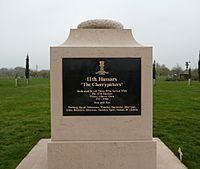
After the war, the regiment was stationed in Berlin in 1945. They moved to different places in Germany before returning home in March 1953. In July 1953, they went to Johor Bahru in Malaya during the Malayan Emergency.
After returning home, they became a training unit in Carlisle in 1956. Then they went back to their armoured reconnaissance role in 1959. In November 1960, they went to Aden before the Aden Emergency. They returned to England in 1961 and then moved to Germany again in 1962. In 1967, they were the first regiment to use the new Chieftain tanks. They stayed in Germany until January 1969. On October 25, 1969, the regiment joined with the 10th Royal Hussars to form the Royal Hussars.
Regimental Museum
The history and items of the 11th Hussars are kept at the HorsePower: The Museum of the King's Royal Hussars. This museum is located at Peninsula Barracks in Winchester.
Famous People from the Regiment
Many notable people served in the 11th Hussars:
- James Brudenell, 7th Earl of Cardigan — He led the Charge of the Light Brigade.
- Alexander Roberts Dunn — The first Canadian to win the Victoria Cross for saving two soldiers during the Charge of the Light Brigade.
- Tim Forster — A racehorse trainer who won the Grand National three times.
- John Ashley Kilvert — A survivor of the Charge of the Light Brigade who later became a mayor.
- David Margesson, 1st Viscount Margesson — A British politician.
- Nicholas Soames — A British politician.
- Prince Michael of Kent — A member of the British Royal Family.
- John Frederick Boyce Combe — A leader in World War II who commanded "Combeforce."
- Ted Dexter — A famous England international cricketer.
Battle Honours
Battle honours are special awards given to military units for their bravery and success in battles. Here are some of the battles where the 11th Hussars earned honours:
- Early wars: Warburg, Egypt, Salamanca, Waterloo, Alma, Balaklava, Inkerman, Sevastopol.
- The Great War: Mons, Le Cateau, Retreat from Mons, Marne 1914, Aisne 1914, Messines 1914, Armentières 1914, Ypres 1914 '15, Somme 1916 '18, Arras 1917, Cambrai 1917 '18, St. Quentin, Amiens, Albert 1918, Hindenburg Line, France and Flanders 1914–18.
- The Second World War: Egyptian Frontier 1940, Sidi Barrani, Buq Buq, Bardia 1941, Capture of Tobruk, Beda Fomm, Halfaya 1941, Tobruk 1941, Sidi Rezegh 1941, Relief of Tobruk, Defence of Alamein Line, Alam el Halfa, El Alamein, Tunis, North Africa 1940–43, Capture of Naples, Italy 1943, Villers Bocage, Mont Pinçon, Dives Crossing, Lisieux, Roer, Rhine, North-West Europe 1944–45.
|


